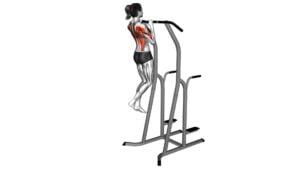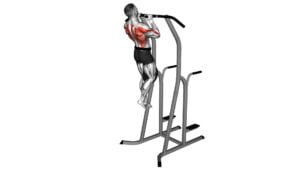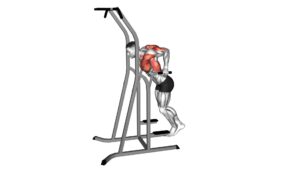Hammer Grip Pull-up on Dip Cage – Video Exercise Guide & Tips

Looking to strengthen your upper body and build those back muscles? Try the hammer grip pull-up on a dip cage!
Watch This Exercise Video
This video exercise guide and tips will show you the proper technique and common mistakes to avoid. You'll also discover variations and progressions to challenge yourself.
Maximize your results with helpful tips and a sample workout routine.
Get ready to take your pull-ups to the next level!
Key Takeaways
- Hammer grip pull-ups engage multiple muscle groups effectively.
- Hammer grip pull-ups reduce stress on wrists and shoulders.
- Hammer grip pull-ups target back muscles and improve grip strength.
- Hammer grip pull-ups strengthen core muscles.
Benefits of Hammer Grip Pull-ups
You can experience numerous benefits from incorporating hammer grip pull-ups into your workout routine. By performing these pull-ups with proper form, you engage multiple muscle groups and activate them effectively. The hammer grip, also known as neutral grip, involves holding the pull-up bar with your palms facing each other. This grip places less stress on your wrists and shoulders compared to other variations, reducing the risk of injury.
One major benefit of hammer grip pull-ups is the activation of your back muscles. This exercise targets your latissimus dorsi, rhomboids, and trapezius muscles, helping to strengthen and develop your upper back. Additionally, it engages your biceps and forearms, leading to improved grip strength.
Moreover, hammer grip pull-ups also work your core muscles. To maintain proper form throughout the exercise, you need to engage your abs and lower back muscles, resulting in a stronger core. This increased stability can translate into better performance in other exercises and activities.
Incorporating hammer grip pull-ups into your routine can provide you with a well-rounded upper body workout, targeting multiple muscle groups simultaneously. Now, let's move on to the next section to learn about the proper technique for hammer grip pull-ups.
Proper Technique for Hammer Grip Pull-ups
To perform hammer grip pull-ups with proper technique, begin by positioning yourself on the dip cage. Here are three key points to keep in mind for proper form and technique:
- Grip: Start by placing your hands on the parallel bars of the dip cage, palms facing each other in a neutral grip. Make sure your hands are shoulder-width apart and your fingers are securely wrapped around the bars.
- Body position: Hang from the bars with your arms fully extended and your feet off the ground. Engage your core muscles to maintain a straight body alignment throughout the movement. Avoid swinging or arching your back.
- Pulling motion: Initiate the movement by squeezing your shoulder blades together and pulling your body upward. Focus on using your back muscles rather than relying solely on your arms. Keep your elbows close to your body as you pull yourself up until your chin is above the bars.
Proper technique is essential for maximizing the benefits of hammer grip pull-ups. By following these guidelines, you can effectively target your back, biceps, and shoulders while building upper body strength. Remember to start with a weight or assistance level that allows you to maintain proper form throughout the exercise.
Common Mistakes to Avoid
Avoiding common mistakes is crucial when performing hammer grip pull-ups on the dip cage. To ensure proper form and technique, it's important to be aware of these common mistakes and avoid them.
One common mistake is using momentum to complete the exercise. It's important to rely solely on your upper body strength to lift yourself up, rather than swinging or kicking your legs.
Another mistake isn't fully extending your arms at the bottom of the movement. Make sure to fully straighten your arms before initiating the next repetition to engage the proper muscles.
Additionally, it's important to maintain a neutral spine throughout the exercise. Avoid arching your back or rounding your shoulders, as this can lead to strain or injury.
Lastly, gripping the handles too tightly can limit your range of motion and make the exercise less effective. Instead, maintain a firm grip without overly tensing your hands.
By avoiding these common mistakes, you can perform hammer grip pull-ups with proper form and technique, maximizing the benefits of this exercise.
Now, let's move on to the next section about variations and progressions.
Variations and Progressions
Now let's talk about the different grip options, increasing difficulty levels, and the benefits of progressions when it comes to Hammer Grip Pull-ups on the Dip Cage.
By changing your grip, you can target different muscles and add variety to your workout.
As you progress, you can increase the difficulty by adding weight or using more challenging variations.
Progressions help you continuously challenge your muscles and improve your strength and performance.
Different Grip Options
You can explore various grip options to progress and add variation to your Hammer Grip Pull-up on the Dip Cage exercise.
Here are three different grip techniques you can try:
- Wide grip: Place your hands wider than shoulder-width apart on the dip cage handles. This grip targets your latissimus dorsi muscles and helps to increase overall upper body strength.
- Close grip: Bring your hands closer together, about shoulder-width apart or slightly narrower. This grip emphasizes your biceps and forearm muscles, providing a challenging workout for your upper body.
- Mixed grip: Use a mixed grip by placing one hand in a pronated position (overhand grip) and the other hand in a supinated position (underhand grip). This grip variation engages different muscle groups in your arms, shoulders, and back, offering a well-rounded workout.
By experimenting with these different grip options, you can target specific muscle groups and keep your Hammer Grip Pull-up on the Dip Cage exercise routine fresh and challenging.
Remember to maintain proper form and listen to your body to prevent injury.
Increasing Difficulty Levels
To challenge yourself and continue progressing with the Hammer Grip Pull-up on the Dip Cage exercise, consider incorporating variations and progressions.
Increasing the intensity of your workouts can help you build strength and improve your overall fitness level. One way to do this is by modifying the exercises. You can start by adding weight to your pull-ups using a weight belt or a weighted vest. This will make the exercise more challenging and help you build more upper body strength.
Another variation is to perform the pull-ups with one arm. This requires even more strength and stability. Additionally, you can try doing explosive pull-ups, where you pull yourself up as quickly as possible.
These variations and progressions will help you continually push yourself and make progress in your fitness journey.
Benefits of Progressions
Incorporating variations and progressions in the Hammer Grip Pull-up on the Dip Cage exercise offers numerous benefits for improving strength and overall fitness. Here are three reasons why you should consider using progression techniques in your workout routine:
- Increased muscle activation: By incorporating different variations of the Hammer Grip Pull-up, such as changing the grip width or adding weights, you can target different muscle groups and increase muscle activation. This helps to stimulate muscle growth and improve overall strength.
- Improved strength gains: Progressions allow you to continually challenge your muscles and push yourself to new limits. As you gradually increase the difficulty level of the exercise, you'll see improvements in your strength and endurance over time.
- Enhanced overall fitness: By incorporating progressions in your workout routine, you're constantly challenging your body in new ways. This helps to improve your overall fitness level, including your cardiovascular endurance, muscular strength, and flexibility.
Tips for Maximizing Your Results
To maximize your results with hammer grip pull-ups on a dip cage, it's important to focus on proper form and technique. Ensure that you maintain a strong grip and engage your back muscles throughout the movement.
Additionally, incorporate progressive overload strategies by gradually increasing the difficulty of the exercise over time.
Lastly, consistency and dedication are key. Make sure to perform the exercise regularly and push yourself to challenge your limits for optimal results.
Form and Technique
Maximize your results by focusing on proper form and technique when performing the hammer grip pull-up on the dip cage. Paying attention to these details won't only help you avoid common errors but also aid in grip strength development.
Here are three essential tips to keep in mind:
- Maintain a neutral spine: Keep your head aligned with your spine and avoid excessive arching or rounding of the back. This ensures proper engagement of the core muscles and reduces the risk of injury.
- Squeeze your shoulder blades: Before initiating the pull-up, retract your shoulder blades and imagine squeezing a pencil between them. This activates the muscles in your upper back, enhancing the effectiveness of the exercise.
- Control the lowering phase: Don't just drop down after pulling yourself up. Instead, slowly lower yourself with control, emphasizing the eccentric portion of the movement. This helps build strength throughout the entire range of motion.
Progressive Overload Strategies
To maximize your results with the hammer grip pull-up on the dip cage, incorporate progressive overload strategies.
Overcoming plateaus and continually challenging your muscles is essential for achieving optimal gains. One effective strategy is incorporating resistance training into your routine. This can be done by using a weight belt or attaching resistance bands to add extra resistance during your pull-ups. Gradually increasing the weight or resistance over time will help your muscles adapt and grow stronger.
Another strategy is varying your grip width or hand position to target different muscles and prevent adaptation. Additionally, you can increase the number of repetitions or sets you perform, or decrease the rest time between sets to further challenge your muscles.
Consistency and Dedication
To achieve maximum results with the hammer grip pull-up on the dip cage, it's important for you to maintain consistency and dedication in your training. Here are three tips to help you stay on track and motivated:
- Set realistic goals: Consistency is easier to maintain when you have clear objectives in mind. Set specific, achievable goals for your pull-up training, such as increasing the number of reps or improving your form.
- Create a routine: Establishing a consistent workout schedule can help you stay motivated and make it easier to stick to your training. Find a time that works best for you and make it a priority in your daily or weekly routine.
- Stay motivated: It's natural to have ups and downs in your fitness journey. Find ways to stay motivated, whether it's tracking your progress, rewarding yourself for reaching milestones, or finding a workout buddy to keep you accountable.
Sample Workout Routine for Hammer Grip Pull-ups
For an effective sample workout routine, incorporate hammer grip pull-ups into your training regimen. Hammer grip pull-ups are a challenging exercise that targets your back, arms, and shoulders.
To get started, you can modify the workout by incorporating bands. Using resistance bands can help you build strength and gradually progress to performing unassisted pull-ups.
Begin by attaching the resistance band to the pull-up bar. Step onto the band and grip the bar with your palms facing each other in a neutral position. Engage your core and pull yourself up until your chin is above the bar. Slowly lower yourself back down to the starting position. Aim for three sets of 8-10 repetitions, resting for 60 seconds between sets.
As you become more comfortable with the exercise, gradually decrease the assistance provided by the resistance band. You can achieve this by using a band with less tension or by moving your grip closer to the bar. Eventually, you'll be able to perform unassisted hammer grip pull-ups.
Remember to maintain proper form throughout the exercise. Keep your shoulders down and back, and avoid swinging or using momentum to complete the movement. With consistent practice and dedication, you'll see improvements in your upper body strength and overall fitness level.
Frequently Asked Questions
How Many Sets and Repetitions Should I Do for Hammer Grip Pull-Ups?
To determine the suitable number of sets and repetitions for hammer grip pull-ups, consider your fitness level and goals. Start with 3 sets of 8-12 reps and gradually increase as you get stronger. Remember, it's important to listen to your body and not push yourself too hard.
Additionally, there are variations of hammer grip pull-ups, such as assisted pull-ups or adding weight, that can provide different challenges and target specific muscle groups.
Can I Do Hammer Grip Pull-Ups if I Have Shoulder or Wrist Injuries?
If you have shoulder or wrist injuries, it's important to modify your hammer grip pull-ups to avoid further damage. Instead of using the dip cage, try using a resistance band or TRX straps for assistance. This will reduce the strain on your shoulders and wrists.
Additionally, focus on strengthening these areas with exercises like shoulder rotations and wrist curls.
Always listen to your body and consult with a healthcare professional before attempting any exercises with an injury.
Are Hammer Grip Pull-Ups Suitable for Beginners?
Hammer grip pull-ups can be suitable for beginners. Incorporating modifications for beginners in hammer grip pull-ups can help you build strength and improve your upper body muscles. This exercise targets your back, biceps, and forearms.
Can I Use an Assisted Pull-Up Machine for Hammer Grip Pull-Ups?
Yes, you can use an assisted pull-up machine for hammer grip pull-ups. This modification allows you to gradually build strength and work towards performing the exercise without assistance.
Hammer grip pull-ups offer several benefits, such as targeting your back and biceps muscles. By using an assisted pull-up machine, you can adjust the resistance to match your current fitness level and gradually decrease it as you become stronger.
This helps in developing proper form and increasing your overall strength.
How Long Does It Take to See Results From Hammer Grip Pull-Ups?
When it comes to seeing results from hammer grip pull-ups, it can vary from person to person. Factors like your current fitness level, consistency, and diet play a role.
However, the benefits of hammer grip pull-ups are worth the effort. They target your back, arms, and shoulders, helping to build strength and muscle.
To keep things interesting, you can try variations like switching grips or adding weights.
Stick with it, and you'll start noticing improvements in no time.
Conclusion
In conclusion, hammer grip pull-ups are an effective exercise for building upper body strength and targeting different muscle groups. By following the proper technique and avoiding common mistakes, you can maximize your results and progress to more challenging variations.
Incorporating hammer grip pull-ups into your workout routine can help you achieve your fitness goals and improve overall strength and muscular endurance.
So grab a dip cage and start reaping the benefits of this powerful exercise.

Author
Years ago, the spark of my life’s passion ignited in my mind the moment I stepped into the local gym for the first time. The inaugural bead of perspiration, the initial endeavor, the very first surge of endorphins, and a sense of pride that washed over me post-workout marked the beginning of my deep-seated interest in strength sports, fitness, and sports nutrition. This very curiosity blossomed rapidly into a profound fascination, propelling me to earn a Master’s degree in Physical Education from the Academy of Physical Education in Krakow, followed by a Sports Manager diploma from the Jagiellonian University. My journey of growth led me to gain more specialized qualifications, such as being a certified personal trainer with a focus on sports dietetics, a lifeguard, and an instructor for wellness and corrective gymnastics. Theoretical knowledge paired seamlessly with practical experience, reinforcing my belief that the transformation of individuals under my guidance was also a reflection of my personal growth. This belief holds true even today. Each day, I strive to push the boundaries and explore new realms. These realms gently elevate me to greater heights. The unique combination of passion for my field and the continuous quest for growth fuels my drive to break new ground.



